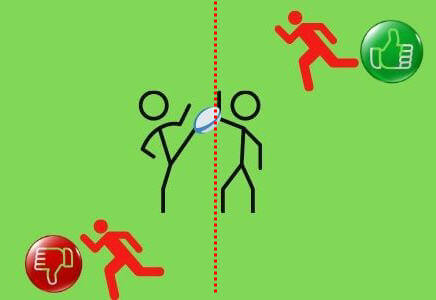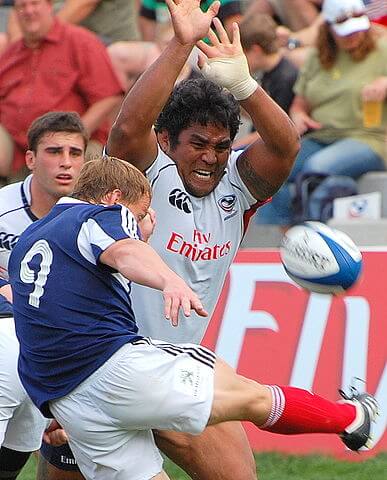When you watch a few rugby matches, you’ll notice that defenders sometimes jump with their arms stretched out to block a kick. But it doesn’t happen very ohften.
Is it foul play in some scenarios? This article looks at when you can or can’t block a kick in rugby.
We’re focusing on kicks in open play. We have a separate article on whether you can block a penalty kick in rugby, or if you can block a conversion. Both those scenarios have different laws.
What Is A Charge Down In Rugby
A charge down is just one type of block in rugby. A picture is worth a thousand words. Here is a classic charge down scenario in open play.
The scrum-half is kicking the ball, which is usually to get play out of his own half. The opposition player launches himself forward, arms raised, targeting the trajectory of the ball.
What if the ball hits the charger’s face?
Looking at the trajectory in the picture above, the charger has got his angles right. The rising ball is more likely to hit an outstretched hand, rather than cannon into his face.
But sometimes players take the ball right into the chops.
What happens? Well, it really hurts. Broken noses are a possible outcome. So players from junior level are trained to charge down with good technique.
However, it’s still a valid charge down. There is no penalty from the ball hitting your chest or head. If you want to know more, check out our article on what happens if you head the ball in rugby.
Other Ways To Block A Kick In Rugby
The classic charge down isn’t the only way to block a kick in open play.
When the attacking team passes the ball out wide across the backline, the defense may spread out so well that there are no gaps big enough to run through without getting tackled.
A classic move is for fly-half or a center to try to kick the ball downfield between the small gaps. The winger rushes forward to try to be first to the ball.
This move backfires completely when the ball ricochets off a defender’s foot and shoots backward toward the attacking team’s try line!
You’ll see defenders flick out their foot to try to get the block.
Why Is A Charge Down Not A Knock On?

On very rare occasions, the attacking player kicks the ball so softly and with such a bad trajectory that the defender catches the ball.
This is an unusual “accident”. Nearly all successful charge downs result in the ball slapping forward (from the defender’s point of view).
But let’s say that the defender catches the ball and then drops it forward. Is this not a knock-on? Yes, usually it is.
An accidental knock-on usually results in a scrum to the opposition team. But not with a charge down!
This doesn’t seem to be in line with the laws governing knock-ons. This is straight from the horse’s mouth i.e. the laws of Rugby Union.
A player must not intentionally knock the ball forward with hand or arm.
IRB Laws
However, the laws include an exception that explicitly mentions charge downs.
The ball is not knocked on, and play continues, if [a] player knocks the ball forward immediately after an opponent has kicked it (charge down).
IRB Laws
The key here is “immediate”.
Suppose the fullback kicks the ball high into the air. That sucker can stay in flight for many seconds.
If a defender pats the ball forward to the ground, goalkeeper-style, that’s a knock-on. The defender can’t say the knock was immediately after the kick.
When is a charge down a knock-on?
I’ve seen the occasional incident when a kicker misskicks the ball without enough height. It cannons toward a hapless defender ten meters away who instinctively raises his hands to his face.
Ball hits hands and ricochets back toward the kicker! That wasn’t immediate i.e. the ball had gone some distance from the kicker’s foot.
Is this a knock-on?
Technically, yes. But few would accuse the flinching defender as having intentionally tried to knock on (which is a penalty and perhaps a yellow card).
If the referee judges this as unintentional, a scrum is awarded to the kicker’s team.
But what if a teammate of the defender jumps onto the ball on the ground? Is the teammate onside or offside? I’ll consider that in the next section.
Blocks, Charge Downs, and Offside Laws In Rugby
Let’s take the scenario when defenders block kicks with a charge down i.e. the ball hits the hand.
What about their teammates? Can they rush forward to win the ball? That depends on where they were standing when the defender touched the ball.
Teammates who are in front of the blocker are in an offside position. This tends to happen when your tired (or lazy) forwards haven’t retreated from a previous ruck.
Here’s a picture to illustrate the good and bad positions:

It can be very tempting to jump onto the ball when you see it ricochet close to you. But if you’re in that lower position, you will give away a penalty.
What Happens When The Ball Goes Out Of Play From A Charge Down?
When the ball rolls out of play from a charge down, the outcome depends on whether it’s across the sideline or over the line of the in-goal area. Let’s look at some specific examples so that this is clear.
Let’s take the scenario when there is a scrum close to the try line of the team who is in possession.
A common exit strategy is to pass the ball back to the fly-half to get a kick away. But the kicker is standing in the in-goal area.
The best possible outcome for the opposition is not just to get a charge down. If they can fall onto the ball, they’ll get a try!
With a small in-goal area, it’s as likely that a charged-down ball flies over the line and out of play.
But what if the ball stays in the in-goal area, and the kicker’s teammate drops onto it to prevent a try?
Let’s work through the answers.
If the kicker’s team grounds the blocked ball in their own in-goal area, the opposition is awarded a scrum on the five-meter line. That’s a fantastic attacking position!
If the ball goes dead from the in-ball area, the outcome depends on where the ball was blocked. If the kicker was inside the in-goal area, then it’s a 22-meter drop-out to the kicker’s team.
If the kicker was in the field of play, then it’s a scrum where the ball was blocked (or a five-meter scrum if it’s closer than five meters to the line).
What if the blocked ball goes over the sideline?
As a charge down is not an infringement, this is the same as if the blocker kicked the ball over the sideline.
The outcome is a line-out to the opposition at the point that the ball crosses the sideline.

2 thoughts on “Can You Block A Kick In Rugby? (All About Charge Downs!)”
Comments are closed.